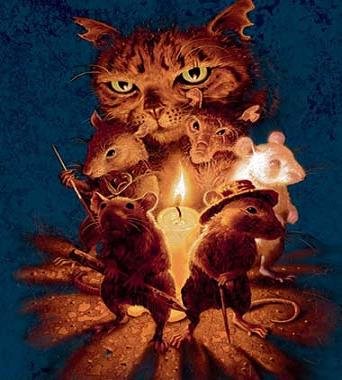The Amazing Maurice and His Educated Rodents, by Terry Pratchett, is a delightful children's book with very mature conversations about morality and ethics and responsibility. The Changelings are set apart from other animals because of their ability to think. With the ability to reason comes the ability, or rather responsibility, to make moral choices. Because the Changelings can think, they can recognize what is, as the kid says, “un-eth-ickle” (4). The ability to think is valued among the rats, but some also recognize that it carries a moral obligation with it.

The Changeling rats can think and this ability sets them apart from other ordinary rats. While the ordinary rats, known as keekees, are animals, the Changeling rats consider themselves as people. Dangerous Beans comments that Maurice makes sure that he does not eat “people who talk” (40), and by “people,” he means rats. In the first pages of the story, the narrator remarks: “As the amazing Maurice said, it was just a story about people and rats. And the difficult part of it was deciding who the people were, and who were the rats” (1-2). The rats are people, or at least refer to themselves as people, because, like humans, they have the ability to think. Because they can think, the rats assume an almost human identity, as the rats have names and, like Sardines who can tap-dance, humanlike characteristics and abilities. The rats not only think but they also have Thoughts which act as a code of conduct for their people. These Thoughts include: “No Rat to Kill Another Rat,” and “We Are The Changelings. We Are Not Like Other Rats” (51-53, 56). These Thoughts indicate that the rats recognize that they are different and that their intelligence proves are they are more than just rats.
The Changelings know that they are intelligent and Dangerous Beans goes even farther to consider what it means to be a rat. Hamnpork says that a rat is: “Teeth. Claws. Tail. Run. Hide. Eat” (54). Hamnpork identifies a rat by physical attributes but Dangerous Beans seeks a deeper answer. Dangerous Beans challenges Hamnpork saying, “But now we can also say ‘what is a rat?...And that means we’re more than that’” (54). Dangerous Beans is referring to the rat’s ability to even ask the question, “what is a rat?”. Dangerous Beans is speaking of thought itself, not the physical brain, that “pinky-grey bit” right “behind your eyes, but “an invisible part that lives inside you” (86-87). It is this invisible part that gives the rats the ability to think and, more importantly, to understand what is right and what is wrong. This understanding truly sets the Changelings apart from the keekee and gives the rats the capability to make moral decisions.
The rats are faced with moral dilemmas, which they can understand as such because of their intelligence. Dangerous Beans believes that rats should not eat or kill other rats. He says: “We can think now. We can think about what we do. We can pity the innocent one who means us no harm” (100). Dangerous Beans recognizes that the Changelings have the responsibility to show pity to the innocent because they can understand what pity is and have the capacity to demonstrate that emotion. The ability to think gives the rats the ability to recognize right from wrong and to act in a moral way. In the same way, Maurice does not eat rats who talk because he recognizes that they are different; they are not animals but instead are people. Maurice recognizes that eating a talking, thinking creature is wrong and immoral when he remarks: “No one can say I’m not highly moral in that respect” (80). The ability to think makes a creature a person and this intelligence carries a moral obligation with it that both the rats and Maurice recognize and uphold.
Pratchett, Terry. The Amazing Maurice and His Educated Rodents. Corgi, 2002.
Image from simonsterg.files.wordpress.com
nice article, I love to read books do you have any link to have the book. thanks for sharing the story.
@rennoelle @muhammadismail92
You can buy the book from Amazon in hard copy or online https://www.amazon.com/Amazing-Maurice-Educated-Rodents-Discworld/dp/0060012358